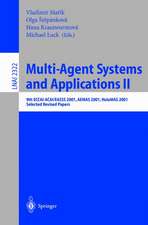Diagrammatic Representation and Inference: 5th International Conference, Diagrams 2008, Herrsching, Germany, September 19-21, 2008, Proceedings: Lecture Notes in Computer Science, cartea 5223
Editat de Gem Stapleton, John Howse, John Leeen Limba Engleză Paperback – 10 sep 2008
Din seria Lecture Notes in Computer Science
- 20%
 Preț: 1061.55 lei
Preț: 1061.55 lei - 20%
 Preț: 307.71 lei
Preț: 307.71 lei - 20%
 Preț: 438.69 lei
Preț: 438.69 lei - 20%
 Preț: 645.28 lei
Preț: 645.28 lei -
 Preț: 410.88 lei
Preț: 410.88 lei - 15%
 Preț: 580.46 lei
Preț: 580.46 lei - 17%
 Preț: 427.22 lei
Preț: 427.22 lei - 20%
 Preț: 596.46 lei
Preț: 596.46 lei -
 Preț: 449.57 lei
Preț: 449.57 lei - 20%
 Preț: 353.50 lei
Preț: 353.50 lei - 20%
 Preț: 1414.79 lei
Preț: 1414.79 lei - 20%
 Preț: 309.90 lei
Preț: 309.90 lei - 20%
 Preț: 583.40 lei
Preț: 583.40 lei - 20%
 Preț: 1075.26 lei
Preț: 1075.26 lei - 20%
 Preț: 310.26 lei
Preț: 310.26 lei - 20%
 Preț: 655.02 lei
Preț: 655.02 lei - 20%
 Preț: 580.93 lei
Preț: 580.93 lei - 20%
 Preț: 340.32 lei
Preț: 340.32 lei -
 Preț: 381.21 lei
Preț: 381.21 lei - 20%
 Preț: 591.51 lei
Preț: 591.51 lei - 15%
 Preț: 438.59 lei
Preț: 438.59 lei - 20%
 Preț: 337.00 lei
Preț: 337.00 lei -
 Preț: 389.48 lei
Preț: 389.48 lei - 20%
 Preț: 607.39 lei
Preț: 607.39 lei - 20%
 Preț: 1024.44 lei
Preț: 1024.44 lei - 20%
 Preț: 579.30 lei
Preț: 579.30 lei - 20%
 Preț: 763.23 lei
Preț: 763.23 lei - 20%
 Preț: 453.32 lei
Preț: 453.32 lei - 20%
 Preț: 575.48 lei
Preț: 575.48 lei - 20%
 Preț: 585.88 lei
Preț: 585.88 lei - 20%
 Preț: 825.93 lei
Preț: 825.93 lei - 20%
 Preț: 763.23 lei
Preț: 763.23 lei - 17%
 Preț: 360.19 lei
Preț: 360.19 lei - 20%
 Preț: 1183.14 lei
Preț: 1183.14 lei - 20%
 Preț: 340.32 lei
Preț: 340.32 lei - 20%
 Preț: 504.57 lei
Preț: 504.57 lei - 20%
 Preț: 369.12 lei
Preț: 369.12 lei - 20%
 Preț: 583.40 lei
Preț: 583.40 lei - 20%
 Preț: 343.62 lei
Preț: 343.62 lei - 20%
 Preț: 350.21 lei
Preț: 350.21 lei - 20%
 Preț: 764.89 lei
Preț: 764.89 lei - 20%
 Preț: 583.40 lei
Preț: 583.40 lei - 20%
 Preț: 649.49 lei
Preț: 649.49 lei - 20%
 Preț: 341.95 lei
Preț: 341.95 lei - 20%
 Preț: 238.01 lei
Preț: 238.01 lei - 20%
 Preț: 538.29 lei
Preț: 538.29 lei
Preț: 341.15 lei
Preț vechi: 426.44 lei
-20% Nou
Puncte Express: 512
Preț estimativ în valută:
65.28€ • 68.33$ • 54.33£
65.28€ • 68.33$ • 54.33£
Carte tipărită la comandă
Livrare economică 31 martie-14 aprilie
Preluare comenzi: 021 569.72.76
Specificații
ISBN-13: 9783540877295
ISBN-10: 3540877290
Pagini: 460
Ilustrații: XV, 445 p.
Dimensiuni: 155 x 235 x 20 mm
Greutate: 0.66 kg
Ediția:2008
Editura: Springer Berlin, Heidelberg
Colecția Springer
Seriile Lecture Notes in Computer Science, Lecture Notes in Artificial Intelligence
Locul publicării:Berlin, Heidelberg, Germany
ISBN-10: 3540877290
Pagini: 460
Ilustrații: XV, 445 p.
Dimensiuni: 155 x 235 x 20 mm
Greutate: 0.66 kg
Ediția:2008
Editura: Springer Berlin, Heidelberg
Colecția Springer
Seriile Lecture Notes in Computer Science, Lecture Notes in Artificial Intelligence
Locul publicării:Berlin, Heidelberg, Germany
Public țintă
ResearchCuprins
Keynote Reflections.- Heterogeneous Reasoning.- Rich Data Representation: Sophisticated Visual Techniques for Ease and Clarity.- Model Driven Development with Mechatronic UML.- Tutorials.- Cognitive Dimensions of Notations: Understanding the Ergonomics of Diagram Use.- Getting Started with Sketch Tools.- Diagram Aesthetics and Layout.- General Euler Diagram Generation.- Euler Diagram Decomposition.- Smooth Linear Approximation of Non-overlap Constraints.- Extremes Are Better: Investigating Mental Map Preservation in Dynamic Graphs.- Psychological and Cognitive Issues.- An Eye-Tracking Study of Exploitations of Spatial Constraints in Diagrammatic Reasoning.- What Diagrams Reveal about Representations in Linear Reasoning, and How They Help.- What Can Pictorial Representations Reveal about the Cognitive Characteristics of Autism?.- Visual Thinking with an Interactive Diagram.- Applications of Diagrams.- Strategy Roadmaps: New Forms, New Practices.- VAST Improvements to Diagrammatic Scheduling Using Representational Epistemic Interface Design.- Enhancing State-Space Tree Diagrams for Collaborative Problem Solving.- Visual Programming with Interaction Nets.- Theoretical Aspects.- Spider Diagrams of Order and a Hierarchy of Star-Free Regular Languages.- Diagrammatic Reasoning System with Euler Circles: Theory and Experiment Design.- A Normal Form for Euler Diagrams with Shading.- Ensuring Generality in Euclid’s Diagrammatic Arguments.- Depicting Negation in Diagrammatic Logic: Legacy and Prospects.- Diagrams in Education.- Transforming Descriptions and Diagrams to Sketches in Information System Design.- Graphical Revelations: Comparing Students’ Translation Errors in Graphics and Logic.- Learning from Animated Diagrams: How Are Mental Models Built?.- Diagrams for theMasses: Raising Public Awareness – From Neurath to Gapminder and Google Earth.- Understanding and Comprehension.- Detection of Sample Differences from Dot Plot Displays.- Visualizing Non-subordination and Multidominance in Tree Diagrams: Testing Five Syntax Tree Variants.- The Effects of Users’ Background Diagram Knowledge and Task Characteristics upon Information Display Selection.- Multimodal Comprehension of Graphics with Textual Annotations: The Role of Graphical Means Relating Annotations and Graph Lines.- Posters.- Talk to the Hand: An Agenda for Further Research on Tactile Graphics.- Openproof - A Flexible Framework for Heterogeneous Reasoning.- Cognitive and Semantic Perspectives of Token Representation in Diagrams.- Estimating Effort for Trend Messages in Grouped Bar Charts.- Types and Programs from Euler Diagrams.- Diagrams in the UK National School Curriculum.- LePUS3: An Object-Oriented Design Description Language.- Utilizing Feature Diagrams to Assess the Capabilities of Tools That Support the Model Driven Architecture.- Diagrammatic Knowledge-Based Tools for Complex Multi-dynamic Processes.- Supporting Reasoning and Problem-Solving in Mathematical Generalisation with Dependency Graphs.- A Concept Mapping Tool for Nursing Education.- Cognitive Methods for Visualizing Space, Time, and Agents.- Benefits of Constrained Interactivity in Using a Three-Dimensional Diagram.- A Strategy for Drawing a Conceptual Neighborhood Diagram Schematically.- Supporting Relational Processing in Complex Animated Diagrams.- Animated Cladograms: Interpreting Evolution from Diagrams.- Automatic Diagram Drawing Based on Natural Language Text Understanding.- Texts and Graphs Elaboration: The Effect of Graphs’ Examination on Recall.- Diagrammatic Logic of Existential Graphs: ACase Study of Commands.- Diagrammatic Reasoning in Separation Logic.- Method of Minimal Representation: An Alternative Diagrammatic Technique to Test the Validity of Categorical Syllogisms.- The Relationship between Graph Comprehension and Spatial Imagery: Support for an Integrative Theory of Graph Cognition.- Using MusicXML to Evaluate Accuracy of OMR Systems.- Aestheticization of Flowcharts.- Towards Diagrammatic Patterns.- Visualizing Meaning: Literacy Materials for Dyslexic Children.- Diagrammatic Interrelationships between Global and Local Algebraic Visual Objects: Communicating the Visual Abstraction.- School Curriculum Development to Promote Student Spontaneous Diagram Use in Problem Solving.
Textul de pe ultima copertă
This book constitutes the refereed proceedings of the 5th International Conference on Theory and Application of Diagrams, Diagrams 2008, held in Herrsching, Germany, in September 2008.
The 25 revised papers and 28 poster papers presented together with 3 keynote papers and 2 tutorial papers were carefully reviewed and selected from 70 submissions. The papers are organized in topical sections on diagram aesthetics and layout, psychological and cognitive issues, applications of diagrams, theoretical aspects, diagrams in education, as well as understanding and comprehension.
The 25 revised papers and 28 poster papers presented together with 3 keynote papers and 2 tutorial papers were carefully reviewed and selected from 70 submissions. The papers are organized in topical sections on diagram aesthetics and layout, psychological and cognitive issues, applications of diagrams, theoretical aspects, diagrams in education, as well as understanding and comprehension.























